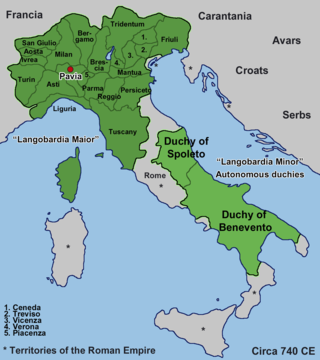
Louis the Pious, also called the Fair and the Debonaire, was King of the Franks and co-emperor with his father, Charlemagne, from 813. He was also King of Aquitaine from 781. As the only surviving son of Charlemagne and Hildegard, he became the sole ruler of the Franks after his father's death in 814, a position that he held until his death except from November 833 to March 834, when he was deposed.
Pope Stephen II was born a Roman aristocrat and member of the Orsini family. Stephen was the bishop of Rome from 26 March 752 to his death. Stephen II marks the historical delineation between the Byzantine Papacy and the Frankish Papacy. During Stephen's pontificate, Rome was facing invasion by the Lombards when Stephen II went to Paris to seek assistance from Pepin the Short. Pepin defeated the Lombards and made a gift of land to the pope, eventually leading to the establishment of the Papal States.
The 800s decade ran from January 1, 800, to December 31, 809.
The 810s decade ran from January 1, 810, to December 31, 819.
The 830s decade ran from January 1, 830, to December 31, 839.
The 790s decade ran from January 1, 790, to December 31, 799.
The 780s decade ran from January 1, 780, to December 31, 789.
The 760s decade ran from January 1, 760, to December 31, 769.
The 750s decade ran from January 1, 750, to December 31, 759.
The 640s decade ran from January 1, 640, to December 31, 649.
The 660s decade ran from January 1, 660, to December 31, 669.
The 680s decade ran from January 1, 680, to December 31, 689.
The 900s decade ran from January 1, 900, to December 31, 909.

Year 806 (DCCCVI) was a common year starting on Thursday of the Julian calendar, the 806th year of the Common Era (CE) and Anno Domini (AD) designations, the 806th year of the 1st millennium, the 6th year of the 9th century, and the 7th year of the 800s decade.

Year 839 (DCCCXXXIX) was a common year starting on Wednesday of the Julian calendar.

Year 900 (CM) was a leap year starting on Tuesday of the Julian calendar.
Pope Paul I was the bishop of Rome and ruler of the emerging Papal States from 29 May 757 to his death. He first served as a Roman deacon and was frequently employed by his brother, Pope Stephen II, in negotiations with the Lombard kings.

Louis II, sometimes called the Younger, was the king of Italy and emperor of the Carolingian Empire from 844, co-ruling with his father Lothair I until 855, after which he ruled alone.

The Kingdom of the Lombards, also known as the Lombard Kingdom and later as the Kingdom of all Italy, was an early medieval state established by the Lombards, a Germanic people, on the Italian Peninsula in the latter part of the 6th century. The king was traditionally elected by the very highest-ranking aristocrats, the dukes, as several attempts to establish a hereditary dynasty failed. The kingdom was subdivided into a varying number of duchies, ruled by semi-autonomous dukes, which were in turn subdivided into gastaldates at the municipal level. The capital of the kingdom and the center of its political life was Pavia in the modern northern Italian region of Lombardy.

The Principality of Benevento was the sole Lombard territory which continued to exist as a rump state, maintaining its de facto independence after the fall of the Kingdom of the Lombards at the hands of the Franks. Benevento dwindled in size in the early 11th century, and was completely captured by the Norman Robert Guiscard in 1053.







